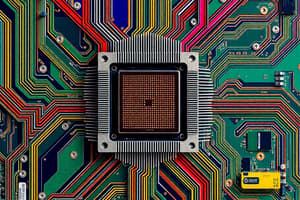Podcast
Questions and Answers
Why is understanding the CPU socket crucial for anyone building or maintaining a computer?
Why is understanding the CPU socket crucial for anyone building or maintaining a computer?
- To know where the processor is located on the motherboard
- To coordinate the actions of various components
- To improve the computer's appearance
- To ensure compatibility between the processor and the motherboard (correct)
What can happen if an incompatible processor is used with a motherboard?
What can happen if an incompatible processor is used with a motherboard?
- The computer will automatically adjust to accommodate the new processor
- The computer may overheat or have poor performance (correct)
- The computer will run faster than with a compatible processor
- The processor will adapt to fit the socket
Which of the following is NOT a common socket type used by Intel processors?
Which of the following is NOT a common socket type used by Intel processors?
- Socket 1151
- Socket 2066
- Socket 2011-3
- Socket AM4 (correct)
What is a major consequence of not knowing the CPU socket type when upgrading a processor?
What is a major consequence of not knowing the CPU socket type when upgrading a processor?
Why is it important for a processor and motherboard to have matching sockets?
Why is it important for a processor and motherboard to have matching sockets?
Flashcards are hidden until you start studying
Study Notes
Motherboard Parts: Understanding the CPU Socket
A motherboard is the central hub of a computer system, connecting and coordinating the actions of various components. Understanding the motherboard's parts, including the CPU socket, is crucial for anyone building or maintaining a computer.
CPU Socket Overview
The CPU socket is the physical connection point on a motherboard where the processor is placed. The socket type can vary depending on the motherboard manufacturer and the specific processor being used. Compatibility between the processor and the motherboard is crucial, as different processors have different pin layouts and can only be used with the appropriate socket.
CPU Socket Types
There are different socket types for Intel and AMD processors. For example, Intel's first generation of socket LGA (Land Grid Array) processors used socket 775, followed by socket 1156, 1155, 1151, 2011, 2011-3, and 2066. AMD has a different socket system, with socket AM2, AM3, AM3+, AM4, and TR4 being some of the most common ones.
Importance of Compatibility
Ensuring that the CPU socket and processor are compatible is crucial for the computer's functionality and preventing damage. Incompatible processors can lead to overheating, poor performance, or even rendering the computer unusable.
Upgrading and Installing a Processor
When upgrading or installing a processor, it is essential to understand the socket type of the current motherboard and the socket type of the new processor. Always follow the manufacturer's instructions for installing a processor and ensure that the thermal solution is applied correctly to prevent damage.
Studying That Suits You
Use AI to generate personalized quizzes and flashcards to suit your learning preferences.




